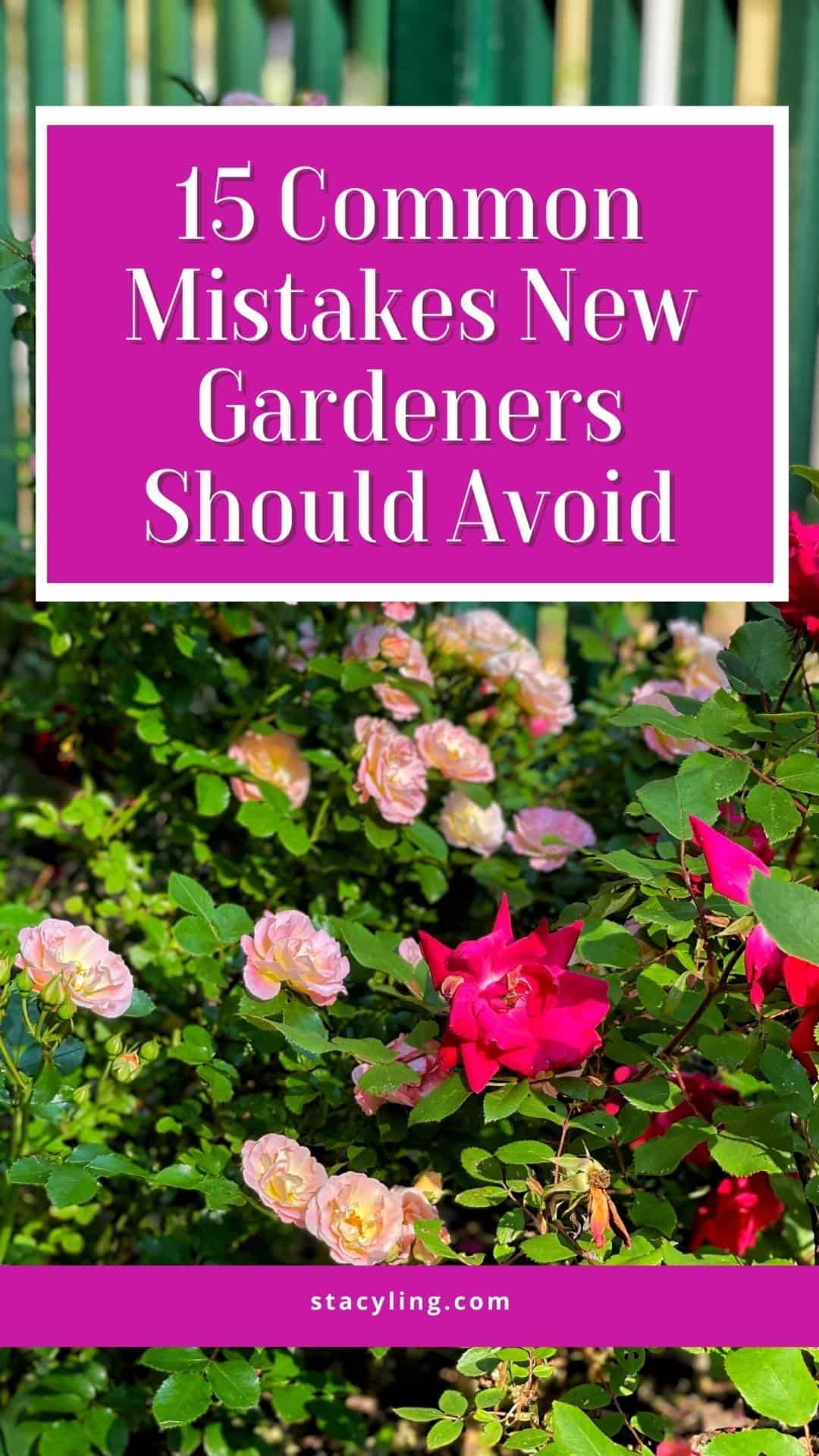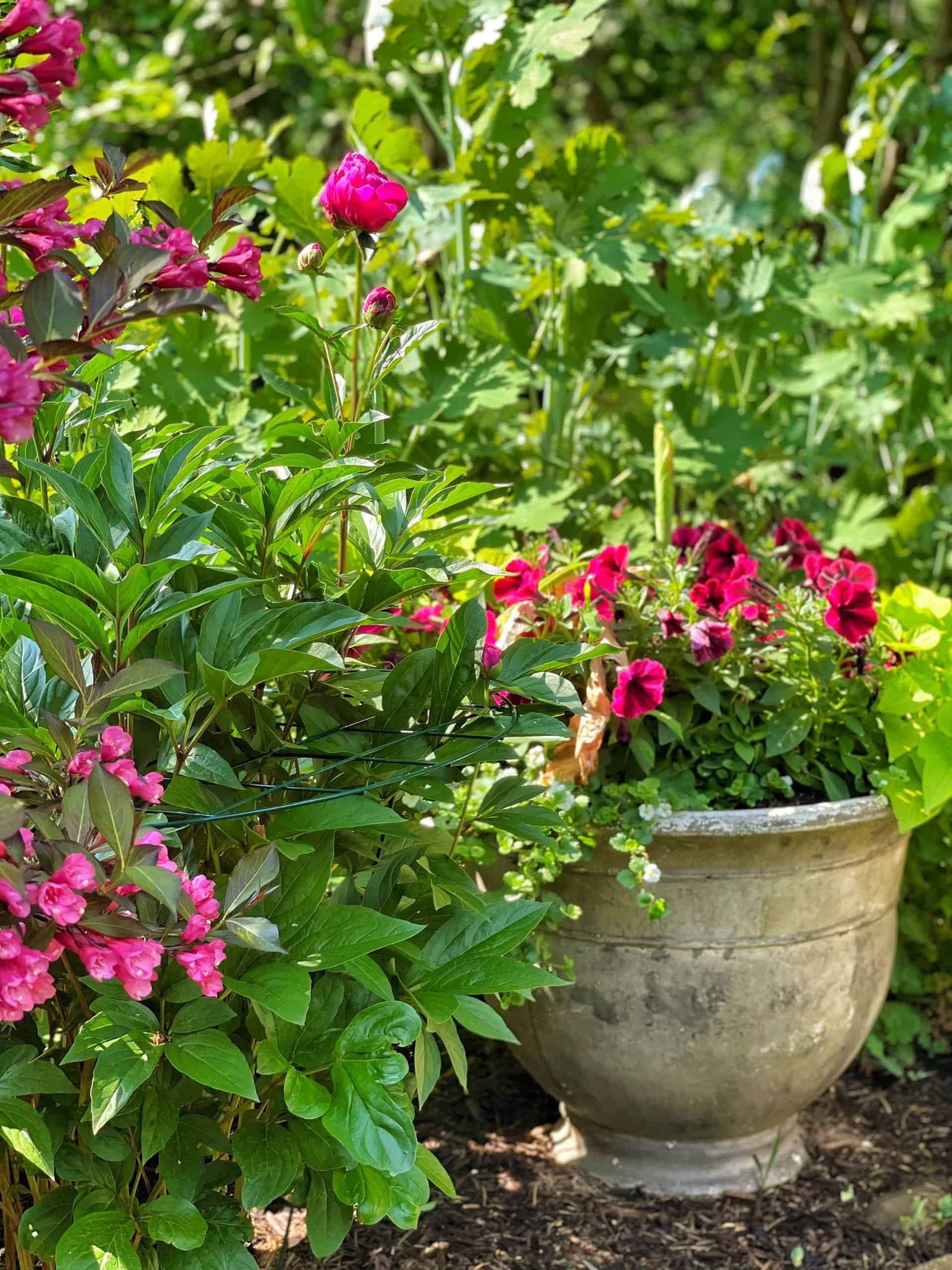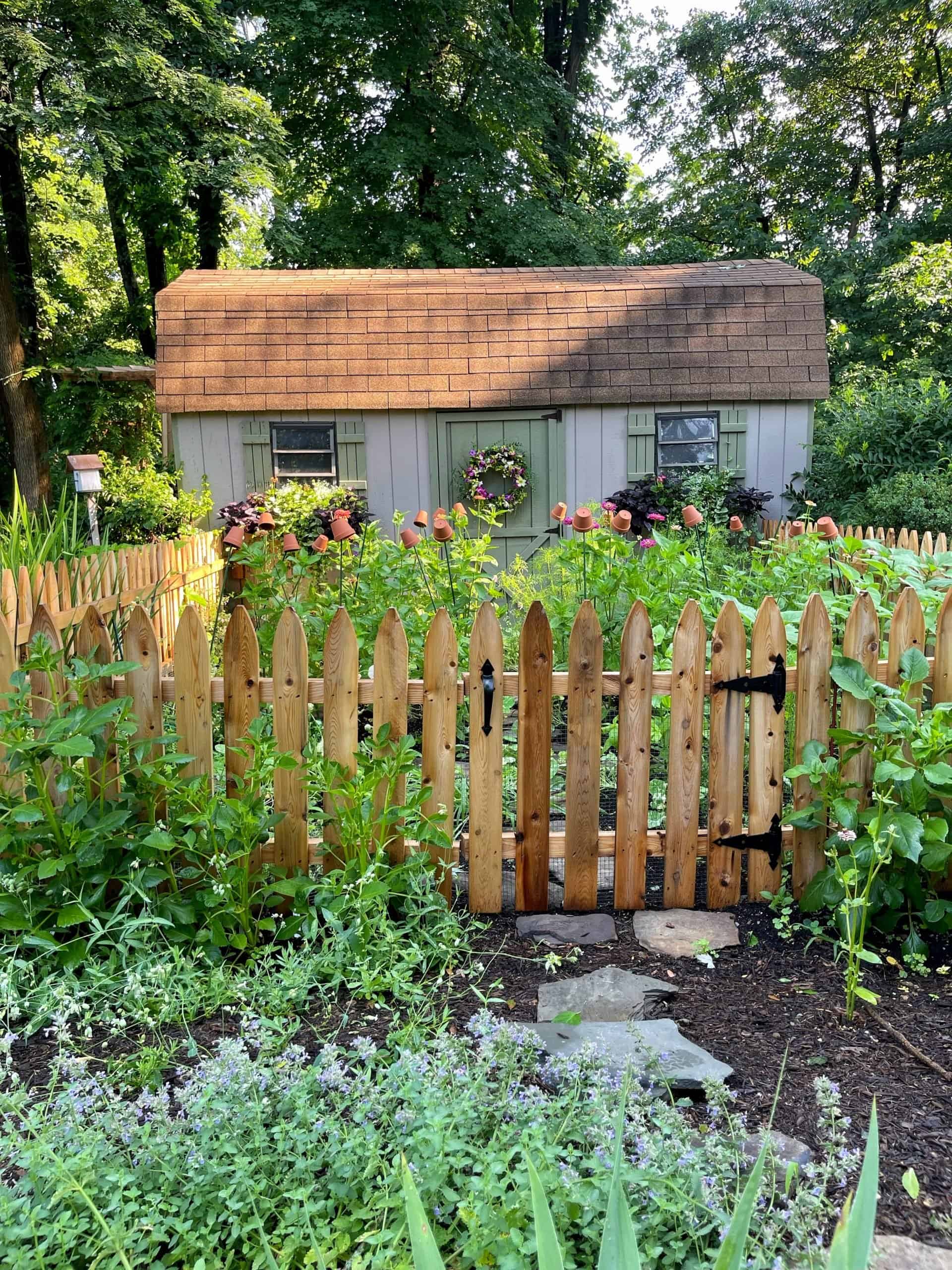Don’t let your garden fail! ❌ Discover the 15 mistakes ALL new gardeners make (and how to avoid them) for a successful growing season. (And be sure to get my FREE printable must-have plant list for what to plant to get continual color and blooms throughout the growing season at the bottom of this post.)
If you are a new gardener, it seems like there’s so much to learn.
Am I right?
But once you understand the basics, you’ll become a more confident and successful gardener. There will be lots of trial and error. Some plants do well and some don’t. And it’s all part of the gardening experience.
But there are some things that we have control over when growing a garden. There are a few gardening basics that when followed will bring the new gardener down a path of success.
And believe me when I tell you I’ve made almost every one of these mistakes at some point in my gardening career. So don’t beat yourself up if you’ve made any of them. Because even the best gardeners still make some of these mistakes today. Myself included! Here’s what you need to avoid to grow a happy, healthy garden both indoors and out.
(Posts on stacyling.com may contain affiliate links. Click HERE for full disclosure.)

15 Mistakes to Avoid as a New Gardener
The following are common mistakes that are listed in no particular order but are commonly made by both new and experienced gardeners alike.
Mistake #1 – New Gardeners Not Knowing Their Hardiness Zone
It’s important to understand what hardiness zone we live in. Knowing our hardiness zone helps us understand how plants will survive in our climates. I live in New Jersey, Zone 6b, so certain plants, like dahlias, won’t survive outside in winter. In those cases, they are either treated as annuals or they must be overwintered indoors. Moreover, some summer-loving annuals may not thrive in cool spring weather. So it’s important to understand how plants will adapt to climate conditions.

Mistake #2 – Not Testing Your Soil
So many home gardeners do not test their soil and wonder why plants fail. And I’m referring to both experienced and new gardeners alike. It’s an extra step that not everyone wants to take but should do. Because If you want to ensure success with what you grow, I strongly recommend testing your soil.
Understanding soil quality is the key to gardening success because you will have a better idea of what will grow best in your soil. Soil test results will provide valuable information as to how good or bad your soil quality is and what should be improved.
For example, some plants prefer acidic soil, while others prefer alkaline. If you plant an acidic loving plant in soil heavy in alkaline, it won’t do well. So it’s important to know the quality and make-up of your soil.
You can contact your local cooperative extension to help test your soil or try a kit like this one. Results will include what your soil conditions are and make recommendations for improvement.

Mistake #3 – Not Keeping Spacing in Mind
Before purchasing plants, it’s important to know how big your garden is so you know what size plants to get. Crowding plants too close together can promote pest and disease problems. Plus, overcrowding can cause one plant variety to choke out another. And we don’t any of that. So read your plant tags, follow the grower’s recommendations, and space plants accordingly.
Mistake #4 – Overwatering
While we could chat about a number of ways to keep gardens and houseplants alive, there is one BIG thing we do wrong without even realizing it. And that is…overwatering.
I know we want to schedule watering on the same day every week. Or we see a plant struggling and we think it needs more water. But rethinking how we water plants will save a lot of heartache when a houseplant succumbs to pest and disease problems due to overwatering.
Why? Because when we overwater, roots stay soggy. Soggy roots promote pest and disease problems. And with some plants, like succulents for example, don’t want to be watered all that often.
With plants, sometimes less is more. And I tend to lean towards underwatering than overwatering. Because oftentimes plants will let you know they are thirsty with droopy leaves. And it’s a little easier to correct than after drowning a plant in water.
Now that’s not to say that all plants will tolerate that, but the easier care ones will.


So be cognizent of the plants you have and what care they require. Read the plant tags and do some research. And before you water houseplants and other container gardens, do this test to see that plants actually need it.
If you have larger outdoor gardens, consider these factors before grabbing that hose:
- Has it rained?
- Will it rain?
- What is the time of day?
- What’s the air temperature?
- How wet is the soil?
And if you are gardening with indoor plants, stick your finger in the soil about 1-2″ down before you water to see if the soil is actually dry where the roots are before blindly watering on the same day every week.

Mistake #5 – Underwatering
Underwatering plants is just as bad as overwatering, but can be a little easier to correct if the plant is easy-going enough.Most plants will let you know they are thirsty when they start drooping and looking kind of sad. Some plants may not recover from severe underwatering while others may bounce back. This is one of those things that you learn from doing.
If you are a beginner gardener, I strongly suggest working with easy-care plants that are hard to kill until you get a feel for caring for them and achieve some success.
Choose easy-care houseplants to grow and low maintenance garden plants like these to help make gardening easier.

Mistake #6 – Planting in the Wrong Location
Location location location. Before buying plants, it’s important to know what light conditions we have in our homes and gardens. And they may be different in various spots of our property and inside our homes.
Depending on where the garden is sited, check to see how much sunlight it gets: full sun (6-8 hours), part sun (4-6 hours), shade (less than 4 hours). If you are starting a new garden outside, consider the type of garden you want to grow with the type of light conditions you have.
When growing plants indoors, determine whether it’s receiving north, south, east, or west-facing window light. And keep indoor plants away from excessive heat and drafts. Read these tips for more specific details about siting houseplants indoors.

Mistake #7 – Not Planting Native Plants
If you are a new gardener, working with native plants is much easier than planting those that are not naturally found in your region or hardiness zone. They are much less work than their non-natives counterparts.
Not sure what’s native in your area? Check with your local cooperative extenstion office, nursery, or fellow gardeners to see what they recommend.
Mistake #8 – New Gardeners Not Reading (and Saving) Plant Tags
Read plant tags to determine light requirements, size, bloom times and variety. Save them in a garden journal or notebook file. Or take a photo of them and save in your phone for easy reference. You’ll thank me for this gardening tip later.
I can’t tell you how many times I’ve gone back to a plant not knowing what the variety is. Saving that plant tag in a garden journal or on your phone will make a big difference in the future. Cause you won’t remember the variety you planted.

Mistake #9 – New Gardeners Taking on More Than They Can Handle
Have you ever heard the saying don’t bite off more than you can chew? The same theory applies to gardening.
Because of the work involved with planting, growing, and maintaining a garden, start small and expand your gardens as you gain experience. Starting with too much too soon is a surefire way to overwhelm yourself as a new gardener and get discouraged.
You can start super small with a few simple container gardens. Or you can start a much larger garden using the easy method.

Mistake #10 – Not Weeding
This is a big one. Yes, you have to weed. There’s no easy way around it, hand pulling or hoeing is the best method to weed gardens. THIS is my favorite hand-weeding tool. THIS is my favorite stand-up weeding tool. I don’t always use a garden hoe, but when I do, it’s one like THIS.
About Chemicals for Weed Control
Please don’t use toxic chemicals to remove weeds. They are really bad for the environment, bad for your garden, bad for the water table, bad for you pets and other wildlife and most importantly, it’s bad for you and your own family’s health. It’s just bad.
And this includes what we put down on the lawn. With all the talk about climate change and the environment, one of the BEST things we can do as individuals is to stop using harmful chemicals in our lawns and gardens.
Think global and act local because it starts with us as homeowners and gardeners. So yes, stop using the lawn chemical service to maintain a thick green lawn and allow some weeds to grow.
Other organic methods to get rid of weeds in the garden are using boiling hot water or home recipes with a mixture of vinegar, dish soap, and Epsom salt.
Learn how to do each of these methods and make a simple homemade weed killer that works here.

What If You Don’t Weed?
Gardens will become overgrown. Weeds zap nutrients from your plants and flowers. And worse, you can grow a weed that can totally take over your garden in such a bad way that you might need to rip it all out.
This happened to me before and it was a disaster.
Several years ago, I was really busy running around with my kids and saw a yellow threading weed growing around plants in my front yard cottage garden. I kept putting off dealing with it. In fact, I wasn’t even sure what it was! Well, I waited so long that it thread its way through my garden and all of my perennial plants.
When I finally read up on what it was (dodder) and how to get rid of it, it was so bad and extended throughout so much of the garden, that I had to rip out all of the affected plants. And it took a few years to eradicate as well.
So stay on top of the weeds!

Mistake #11 – New Gardeners Not Inspecting Plants Before Buying at the Nursery
Before bringing a plant home from the nursery, always check it out. Make sure you don’t see any bugs on the leaves, stems or soil.
Be sure to check the undersides of plant leaves. But also, check the foliage to ensure there is not yellowing or fungal spots.
The last thing you want to do is bring a plant home that has pest and disease problems that you’ll introduce to the rest of your garden.
And if you can, remove the plant from the plastic pot and check the root system to see how root-bound it is and how healthy the roots are.
If the roots are soft, mushy, and decayed, don’t buy it.

Mistake #12 – Not Considering the Critters
For me, deer are a huge problem so I follow these tips to deer-proof my garden and focus on choosing the right plants that deer tend to avoid. But I’ve also had problems with rabbits, chipmunks, groundhogs, squirrels, and birds. Keep a close eye on your gardens. Walk the beds every day to catch wildlife problems early.
Mistake #13 – Not Caring for Plants While On Vacation
Before heading out for vacation, even if it’s just for a weekend, make sure your plants and garden have the care they need to survive while you are away. You spent so much time starting, growing, and nurturing your gardens, don’t leave it to chance that your gardens will take care of themselves. Follow these great tips to keep your gardens happy and healthy while you are on vacation.
Mistake #14 – Not Planting Near a Water Source
When growing a garden, know where your water source is located. If a water source is really far away, it will be tough to establish new plants or keep plants hydrated during the heat of summer.
My former vegetable garden was really far away from a water source and it was difficult to keep the garden watered as needed, particularly in summer. As a result, my vegetable harvest suffered from inconsistent watering.
A few years ago, I moved my vegetable garden to these self-watering raised garden bed planters that kept my gardens evenly watered at the roots all season long. It was much easier to keep them hydrated than dragging a hose around 50-100′. I mean, you can do it, but it stinks to do it every day in the blazing heat of summer.
So don’t make the same mistake I did and really think about where that water source is and how you will water plants.

Mistake #15 – New Gardeners Not Feeding Plants
New gardeners often ask me what to feed plants often. For perennials, shrubs, and trees, I recommend focusing on good soil quality. Amend the soil yearly with compost, leaf mold, other organic materials, and mulch. That’s it.
- For vegetables, I recommend a good organic plant food like THIS.
- For roses care, I recommend using THIS.
I had THE BEST rose blooms this year which I largely attribute to the plant food I used. You can check it out HERE.
Annuals, houseplants, and container gardens need to be fertilized. Since annuals have such a short life span, it’s important to feed them with a well-balanced fertilizer so they bloom profusely through the season.
Where houseplants and container gardens are concerned, they also need nutrients so they can grow I love using THIS slow-release fertilizer for my annuals, houseplants, and container gardens because it is set and forget.
And note, when using any sort of fertilizer, ALWAYS follow the manufacturer’s directions.
Read more here for more container gardening tips. And read more here to learn why we should treat perennials and annuals differently.

More Mistakes New Gardeners Should Avoid
Have you made any of these mistakes before? Have you made any other mistakes new gardeners make that is not mentioned in this list? I would love to know more in the comments below.
For more common gardening mistakes to avoid, check out this article from the Illinois Cooperative Extension.
Thank you so much for following along.
Enjoy a beautiful day! xo





Want to Learn What to Plant for an Everblooming Colorful Garden?
Click here to get my FREE Must-Have Plant List!
Be the plant parent you’ve always wanted to be with these tried and true flowers that will give you a beautiful garden that’s always in bloom.























